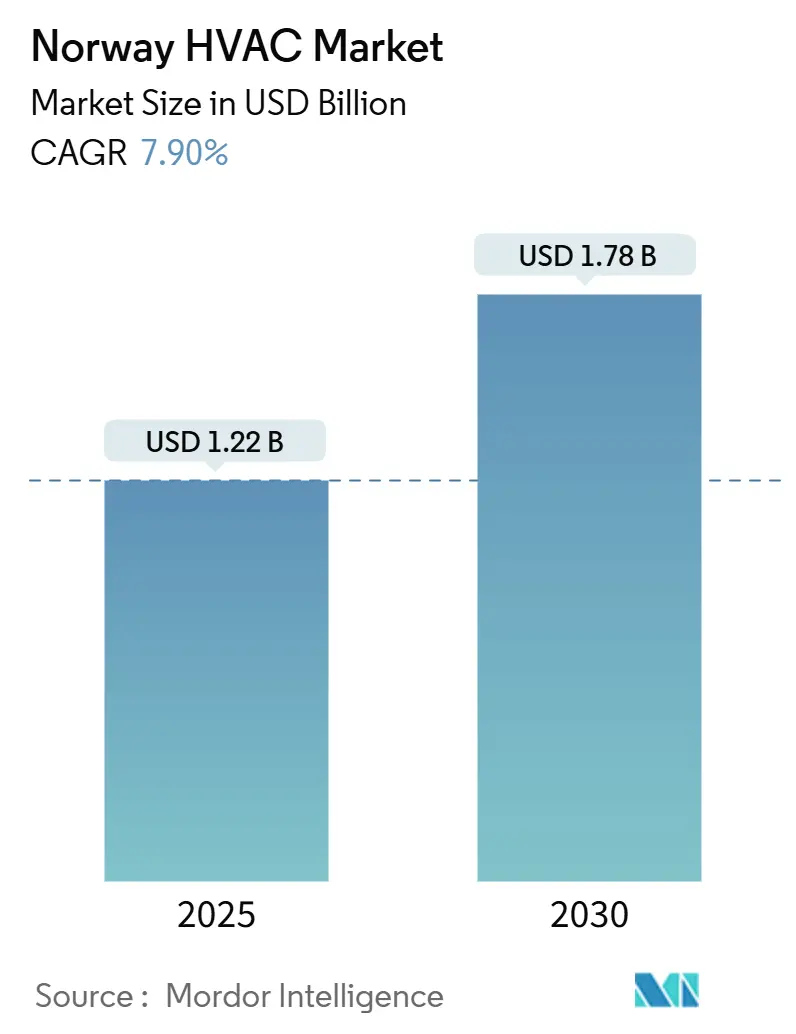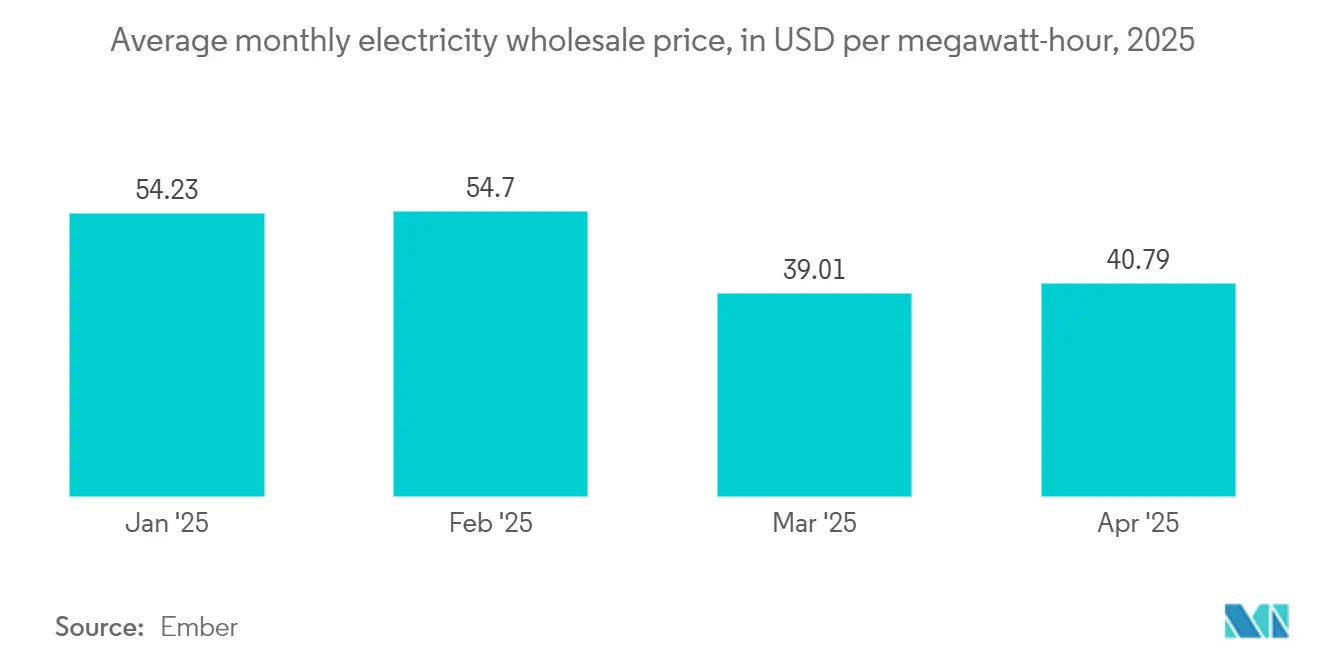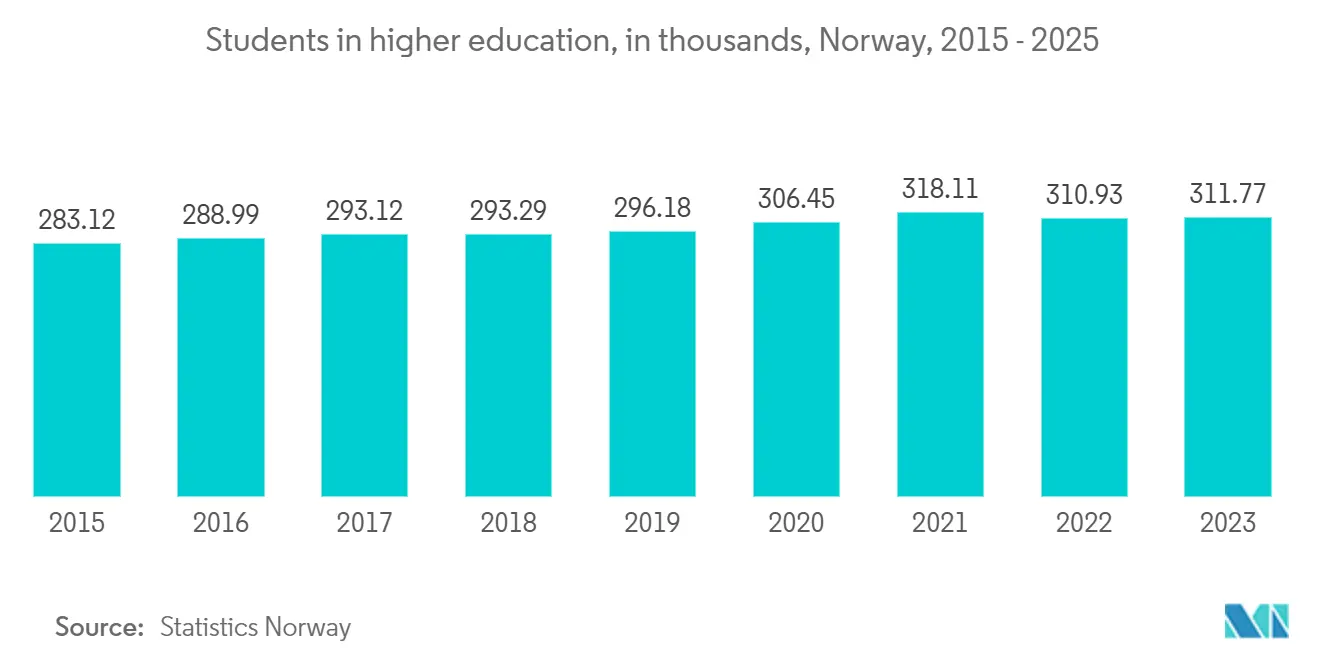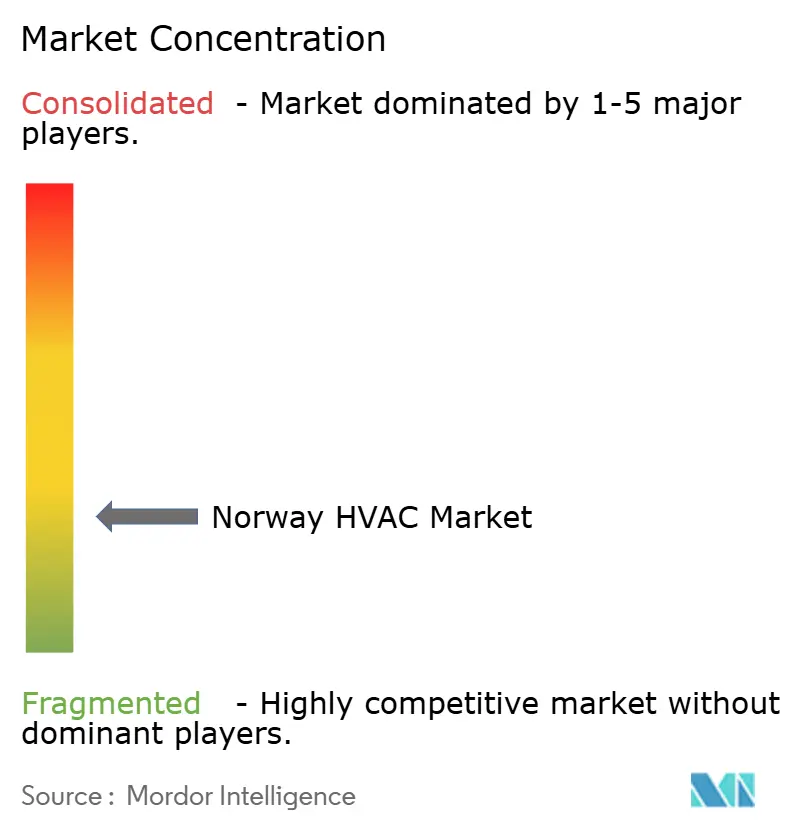Norway HVAC Market Size and Share

Norway HVAC Market Analysis by Mordor Intelligence
The Norway HVAC Market size is estimated at USD 1.22 billion in 2025, and is expected to reach USD 1.78 billion by 2030, at a CAGR of 7.90% during the forecast period (2025-2030).
- Norway's long, frigid winters necessitate efficient heating solutions. Modern, energy-efficient systems are gradually supplanting traditional methods, offering enhanced indoor comfort and reduced energy consumption.
- Norway's stringent environmental policies target carbon emission reductions and advocate for energy-efficient HVAC systems. To further this agenda, the government has rolled out incentives encouraging businesses and homeowners to embrace renewable energy heating solutions, including heat pumps and district heating systems. These efforts have hastened the shift towards sustainable HVAC technologies, positioning Norway as a beacon of green innovation in the sector.
- The market is witnessing a transformation with the rise of IoT-enabled HVAC systems. These innovations empower users to fine-tune energy consumption and oversee indoor air quality in real-time. Features like smart thermostats, automated climate control, and AI-driven predictive maintenance are becoming commonplace in both commercial and residential settings. Beyond boosting efficiency, these technologies promise significant cost savings, making them appealing to a broad audience.
- As awareness of health and wellness grows, so does the demand for HVAC systems that enhance indoor air quality. Cutting-edge filtration technologies, including HEPA filters and UV-C light sterilization, are now integral to HVAC systems, effectively removing pollutants, allergens, and pathogens. This demand surge is especially pronounced in commercial spaces, healthcare facilities, and educational institutions, where clean air is paramount for occupant health.
- Yet, despite the clear advantages of energy-efficient HVAC systems, high initial investments and maintenance costs pose significant hurdles. Technologies like geothermal heating and smart climate control systems demand hefty upfront capital, often putting them out of reach for small businesses and lower-income households. Coupled with ongoing maintenance and servicing costs, these financial challenges hinder broader adoption.
Norway HVAC Market Trends and Insights
Growing need for energy-saving HVAC systems is expected to drive the market
- Norway's stringent environmental policies are not just about regulations; they're about fostering a green revolution. With incentives in place, both businesses and homeowners are increasingly turning to renewable energy solutions. From heat pumps to district heating systems, these eco-friendly choices are reshaping Norway's HVAC landscape, positioning the nation as a beacon of green innovation.
- Norway's government has rolled out a series of sustainability acts in 2024, underscoring its commitment to energy-efficient HVAC systems and a marked reduction in carbon emissions. Central to these efforts is the Climate Act, which sets a bold target: a 55% cut in greenhouse gas emissions by 2030, benchmarked against 1990 levels. To bolster transparency and accountability, the act mandates annual updates from the government on both national and sector-specific emission reduction strategies.
- Norwegian developers are leading the charge in green building initiatives, emphasizing energy-efficient designs and sustainable construction. As passive house standards and zero-energy buildings gain traction, the demand for aligned HVAC systems has surged. Builders and architects are now integrating advanced ventilation and heating solutions that prioritize energy conservation without compromising indoor comfort. This momentum towards carbon-neutral buildings is further propelling the uptake of energy-efficient HVAC technologies.
- Norway's electricity prices, swayed by global energy market dynamics, have led both businesses and homeowners to hunt for economical heating and cooling solutions. Systems like geothermal heating and high-efficiency heat pumps not only curtail electricity use but also trim utility bills. There's a notable uptick in the demand for solar-powered HVAC units, as consumers pivot towards sustainable alternatives. The evident financial advantages of these energy-efficient systems are fueling the market's expansion.
- For instance, data from Ember, an independent global energy think tank, highlights the trends. In April 2025, Norway's average wholesale electricity price was EUR 36.08 per megawatt-hour (~USD 40.79/MW-h). However, in August 2022, prices soared to a staggering record of EUR 246 per megawatt-hour (~USD 277.91/MW-h), driven by a global energy crisis and a summer drought.

Commercial Sector is Expected to hold the largest share
- As urban areas expand and economies flourish, modern office spaces and bustling business districts are emerging. In a bid to boost employee productivity and comfort, companies are turning to high-performance HVAC systems, ensuring top-notch indoor air quality and precise temperature control. Furthermore, with the rise of smart HVAC solutions, businesses can seamlessly integrate these systems with building management platforms, enabling real-time energy monitoring and optimization. This not only curbs operational costs but also guarantees a pleasant indoor atmosphere.
- Key players in the HVAC arena include hospitals, clinics, and educational institutions. Healthcare settings demand specialized HVAC systems to uphold sterile conditions, manage humidity levels, and guarantee effective air filtration. In parallel, universities and schools are channeling investments into HVAC solutions, prioritizing optimal learning environments. With a heightened focus on indoor air quality in both healthcare and education, there's a notable surge in the adoption of advanced HVAC technologies, emphasizing air purity and energy efficiency.
- Norway is on a mission to bolster its educational infrastructure, actively constructing new schools and universities. In Harstad, a new educational institution is taking shape, poised to be both a school and a cultural landmark. Peab, a prominent Nordic construction firm, has clinched the contract for the Vigra School in Giske, Norway, targeting a completion date of February 2027. On the university front, Norway is channeling investments into higher education infrastructure, with funding models benefiting both public and private entities. As these new educational buildings rise, they are set to give a boost to the HVAC market, underscoring the demand for modern heating, ventilation, and air conditioning systems. These systems are not just a luxury; they are essential for meeting energy efficiency standards and ensuring a comfortable learning environment.
- Norway is on a mission to bolster its educational infrastructure, actively constructing new schools and universities. A prime example is a new institution in Harstad, envisioned not just as a school but also as a cultural landmark. In another development, Peab, a prominent Nordic construction firm, has clinched the contract for the Vigra School in Giske, Norway, with an anticipated completion date set for February 2027. Norway's commitment to higher education is evident, as the nation pours investments into its infrastructure, backing both public and private institutions through innovative funding models. These new educational edifices, equipped with state-of-the-art heating, ventilation, and air conditioning (HVAC) systems, not only adhere to energy efficiency standards but also ensure a conducive learning atmosphere, signaling a robust demand for the HVAC market.
- Statistics Norway reports a significant uptick in higher education enrollment over the past decade. In 2010, Norway boasted around 240,000 students in higher educational institutions. Fast forward to 2023, and that figure has surged to over 310,000. This burgeoning student population is set to further energize the HVAC market, as expanding university infrastructures will necessitate modern HVAC solutions for new campus buildings, dormitories, and research facilities.

Competitive Landscape
Norway's HVAC market is on a steady rise, fueled by a growing appetite for energy-efficient solutions and tightening environmental regulations. With technological advancements and backing from government initiatives, Norway's HVAC market is poised for further growth. As the industry evolves, manufacturers are innovating, placing a premium on energy-efficient and smart HVAC solutions to cater to changing consumer preferences.
The Norway HVAC Market is Segmented by Product Type (Heating Equipment (Heat Pumps, Furnaces, Boilers, Unit Heaters, and Others), Ventilation Equipment (Air Handling Units (AHUs), Energy Recovery Ventilators (ERVs)/Heat Recovery Ventilators (HRVs), Exhaust and Supply Fans, and Dehumidifiers/Humidifiers), and Air Conditioning Equipment (Unitary Air Conditioners (Split Air Conditioners, Packaged Terminal ACs, and Rooftop Packaged Units), Variable Refrigerant Flow (VRF) Systems, Chillers, Fan Coil Units, and Others)), and End-User Industry (Residential, Commercial, and Industrial). The Market Sizes and Forecasts are Provided in Terms of Value (USD) for all the Above Segments.
Norway HVAC Industry Leaders
-
Johnson Controls International Plc.
-
Daikin Industries Ltd.
-
Panasonic Holdings Corporation
-
Trane Technologies Plc.
-
Mitsubishi Electric
- *Disclaimer: Major Players sorted in no particular order

Recent Industry Developments
- March 2025: Redningsselskapet, the Norwegian Society for Sea Rescue, has selected Aeron to supply the entire HVAC system for its 32-meter search and rescue (SAR) vessel. This humanitarian organization is committed to rescuing individuals and vessels along Norway's coastline. The vessel, still under construction, is set to be completed in 2026.
- June 2024: LG identified Norway as an ideal location for testing its heat pumps, enlisting the expertise of both OsloMet and NTNU. Additionally, the University of Naples Federico II in Italy, renowned for its research on heating, ventilation, and air conditioning (HVAC) in frigid climates, joined the initiative. In the winter of 2024, Northern Europe faced an unprecedented cold snap, with temperatures plunging below minus 40 degrees Celsius in certain regions. In response, LG is forging partnerships with various institutions to engineer heat pumps that ensure optimal heating performance, even in such severe cold.
Norway HVAC Market Report Scope
The HVAC (Heating, Ventilation, and Air Conditioning) market focuses on delivering temperature regulation, air quality control, and ventilation solutions across residential, commercial, and industrial spaces. This market spans a diverse array of systems, equipment, and services, all aimed at ensuring indoor comfort, promoting energy efficiency, and championing environmental sustainability.
The Norway HVAC Market is Segmented by Product Type (Heating Equipment (Heat Pumps, Furnaces, Boilers, Unit Heaters, and Others), Ventilation Equipment (Air Handling Units (AHUs), Energy Recovery Ventilators (ERVs)/Heat Recovery Ventilators (HRVs), Exhaust and Supply Fans, and Dehumidifiers/Humidifiers), and Air Conditioning Equipment (Unitary Air Conditioners (Split Air Conditioners, Packaged Terminal ACs, and Rooftop Packaged Units), Variable Refrigerant Flow (VRF) Systems, Chillers, Fan Coil Units, and Others)), and End-User Industry (Residential, Commercial, and Industrial). The Market Sizes and Forecasts are Provided in Terms of Value (USD) for all the Above Segments.
| Heating Equipment | Heat Pumps (Air Source, Ground Source) | |
| Furnaces (Gas, Electric, Oil) | ||
| Boilers (Condensing, Non-condensing) | ||
| Unit Heaters | ||
| Others (Radiators & Baseboard Heaters, Solar Water Heating Systems) | ||
| Ventilation Equipment | Air Handling Units (AHUs) | |
| Energy Recovery Ventilators (ERVs) / Heat Recovery Ventilators (HRVs) | ||
| Exhaust and Supply Fans | ||
| Dehumidifiers / Humidifiers | ||
| Air Conditioning Equipment | Unitary Air Conditioners | Split Air Conditioners |
| Packaged Terminal ACs (PTACs) | ||
| Rooftop Packaged Units (RTUs) | ||
| Variable Refrigerant Flow (VRF) Systems | ||
| Chillers (Air-Cooled, Water-Cooled) | ||
| Fan Coil Units (FCUs) | ||
| Others (Window and Portable Air Conditioners) | ||
| Residential |
| Commercial |
| Industrial |
| By Product Type | Heating Equipment | Heat Pumps (Air Source, Ground Source) | |
| Furnaces (Gas, Electric, Oil) | |||
| Boilers (Condensing, Non-condensing) | |||
| Unit Heaters | |||
| Others (Radiators & Baseboard Heaters, Solar Water Heating Systems) | |||
| Ventilation Equipment | Air Handling Units (AHUs) | ||
| Energy Recovery Ventilators (ERVs) / Heat Recovery Ventilators (HRVs) | |||
| Exhaust and Supply Fans | |||
| Dehumidifiers / Humidifiers | |||
| Air Conditioning Equipment | Unitary Air Conditioners | Split Air Conditioners | |
| Packaged Terminal ACs (PTACs) | |||
| Rooftop Packaged Units (RTUs) | |||
| Variable Refrigerant Flow (VRF) Systems | |||
| Chillers (Air-Cooled, Water-Cooled) | |||
| Fan Coil Units (FCUs) | |||
| Others (Window and Portable Air Conditioners) | |||
| By End-User | Residential | ||
| Commercial | |||
| Industrial | |||
Key Questions Answered in the Report
How big is the Norway HVAC Market?
The Norway HVAC Market size is expected to reach USD 1.22 billion in 2025 and grow at a CAGR of 7.90% to reach USD 1.78 billion by 2030.
What is the current Norway HVAC Market size?
In 2025, the Norway HVAC Market size is expected to reach USD 1.22 billion.
Who are the key players in Norway HVAC Market?
Johnson Controls International Plc., Daikin Industries Ltd., Panasonic Holdings Corporation, Trane Technologies Plc. and Mitsubishi Electric are the major companies operating in the Norway HVAC Market.
What years does this Norway HVAC Market cover, and what was the market size in 2024?
In 2024, the Norway HVAC Market size was estimated at USD 1.12 billion. The report covers the Norway HVAC Market historical market size for years: 2019, 2020, 2021, 2022, 2023 and 2024. The report also forecasts the Norway HVAC Market size for years: 2025, 2026, 2027, 2028, 2029 and 2030.
Page last updated on:
Norway HVAC Market Report
Statistics for the 2025 Norway HVAC market share, size and revenue growth rate, created by Mordor Intelligence™ Industry Reports. Norway HVAC analysis includes a market forecast outlook for 2025 to 2030 and historical overview. Get a sample of this industry analysis as a free report PDF download.



